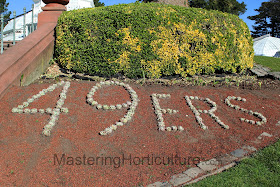Dioscorea macrostachya
Synonym: Dioscorea mexicana
Family: Dioscoreaceae
Common Name:Tortoise Plant
Country of Origin: Panama, El Salvador, Mexico
Fig. 1 Caudex on close-up view - resembles a tortoise shell.
The caudex which is the thickened and enlarged base of the stem is what gives this plant an extraordinary visual appeal. Part of the caudex grows above-ground exposing a hardened outer layer that resembles a tortoise shell . As the caudex expands, the hardened layer breaks into almost regular polygonal plates that becomes protuberant with age leaving deep furrow in between (Fig. 1).
Fig. 2 Flowers and leaves on long vines
The pictures here are images of the specimen Dioscorea macrostachya at the Conservatory of Flowers in San Francisco. From the appearance of the stem and leaves, this perennial plant looks like and ordinary vine (Fig. 2). Capable of growing up to 36 feet in a year, this plant is a vigorous grower. Unless you take the time to guide your eyes to follow where the vine originates, it would be so hard to imagine that the caudex below (Fig. 3) is related to the far-reaching vine with the heart-shaped leaves.
The plant
Fig. 3 Branches arising from the caudex.
As a normal sequence of events, every year, a new set of branches emerge from the apical end of the caudex and dies back at the end of the season depending on growing conditions. In the tropical forest where this plant would be found in nature, the caudex would be sitting in the shade where it prefers to be with lots of water. Sunlight requirement for this plant is relatively moderate. The new vine would then have to reach up above the other plant canopies to access to direct sunlight. Thus a rapid growth of the vine is necessary for existence. The rate of growth of the caudex is a function of the photosynthetic rate on the foliage.
Fig. 4 The Caudex: Tortoise-like
Dioscorea macrostachya is grown as an ornamental plant as it adds oddity to any plant collection.
Suggested reading on Caudiciforms:
http://www.bihrmann.com/caudiciforms/subs/dio-mex-sub.asp
http://www.bihrmann.com/caudiciforms/subs/dio-mex-sub.asp
Find time to walk in a garden today.
















